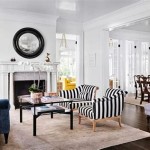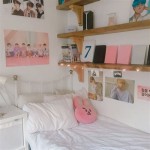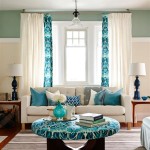How To Decorate A Room With Windows
Windows are a focal point in any room, providing natural light, ventilation, and views of the outdoors. Effectively decorating a room with windows enhances these benefits and complements the overall aesthetic. This process involves considering window treatments, furniture placement, color palettes, and accessories to create a cohesive and visually appealing space. The goal is to maximize the natural light while ensuring privacy and controlling glare, all while aligning with the room's function and the individual's preferences.
Selecting Appropriate Window Treatments
Window treatments are essential for controlling light, maintaining privacy, and adding to the room's decorative appeal. Different types of window treatments offer varying levels of light control and insulation, so choosing the right ones is critical. Common options include curtains, blinds, shades, and shutters, each with its own set of advantages and disadvantages.
Curtains are fabric panels that hang from a rod and come in various styles, materials, and patterns. They can be sheer, semi-sheer, or opaque, offering different levels of light filtration and privacy. Sheer curtains allow ample natural light to enter while providing a degree of privacy. Opaque curtains, often referred to as blackout curtains, completely block out light, making them ideal for bedrooms or media rooms. The choice of fabric significantly impacts the curtains' appearance and functionality. Linen and cotton offer a light and airy feel, while velvet and silk provide a more luxurious and formal look.
Blinds consist of horizontal or vertical slats made of wood, vinyl, aluminum, or fabric. They offer precise control over light and privacy by adjusting the angle of the slats. Venetian blinds, with horizontal slats, are a popular choice for their versatility and ease of use. Vertical blinds are often used for large windows or sliding doors, providing a sleek and modern look. Blinds can be easily cleaned and maintained, making them a practical option for many rooms.
Shades are fabric panels that can be raised or lowered to control light and privacy. There are several types of shades, including roller shades, Roman shades, and cellular shades. Roller shades are a simple and affordable option, consisting of a single piece of fabric that rolls up and down. Roman shades are made of fabric that folds up in pleats when raised, adding texture and dimension to the window. Cellular shades, also known as honeycomb shades, have a unique honeycomb structure that provides insulation and energy efficiency. Shades offer a clean and streamlined look, and they come in a variety of colors and patterns to complement any decor.
Shutters are solid or louvered panels that are hinged to the window frame. They provide excellent light control, privacy, and insulation. Shutters can be adjusted to allow varying amounts of light into the room, and they can be completely closed for maximum privacy. They are a durable and long-lasting option, adding architectural interest to the space. Shutters are available in wood, vinyl, and composite materials, allowing for customization to match the room's style.
When selecting window treatments, consider the room's function, the amount of natural light desired, and the level of privacy needed. For example, a bedroom may benefit from blackout curtains or shades to ensure a dark and restful sleep environment. A living room may benefit from sheer curtains or blinds that allow natural light while maintaining privacy. The overall style of the room should also be taken into account when choosing window treatments; for example, a modern room may benefit from sleek roller shades or minimalist blinds, while a traditional room may benefit from elegant curtains or shutters.
Optimizing Furniture Placement Around Windows
Furniture placement is crucial for maximizing the benefits of natural light and creating a functional and aesthetically pleasing space. The placement should consider the size and shape of the room, the location of the windows, and the intended use of the space. Arranging furniture to take advantage of natural light can significantly enhance the room's ambiance and functionality.
Avoid blocking windows with large pieces of furniture. Doing so can obstruct natural light and make the room feel smaller and darker. Instead, position furniture to allow light to flow freely into the room. Sofas and chairs can be placed perpendicular to windows to create seating areas that are bathed in natural light. Smaller accent pieces, such as side tables or plants, can be placed near windows to add visual interest without blocking the light.
Consider the orientation of the windows and how sunlight will impact the room throughout the day. East-facing windows receive the most sunlight in the morning, while west-facing windows receive the most sunlight in the afternoon. Position furniture to minimize glare and heat gain, especially in rooms with west-facing windows. Using window treatments that filter or block light can also help to mitigate these issues.
Create a focal point near the window. This could be a comfortable reading chair, a decorative plant, or a piece of artwork. By creating a focal point, the eye is drawn to the window and the natural light it provides. It also helps to integrate the window into the overall design of the room.
Utilize window seats or built-in benches to maximize space and create a cozy nook. Window seats are a perfect place to relax and enjoy the natural light and views from the window. They can also provide valuable storage space, making them a practical addition to any room. Built-in benches can be customized to fit the dimensions of the window and the style of the room, creating a seamless and integrated design.
When arranging furniture, consider the flow of traffic through the room. Ensure that there is enough space to move comfortably around the furniture without bumping into it. Avoid placing furniture in a way that obstructs doorways or pathways. This will help to create a functional and inviting space that is easy to navigate.
Experiment with different furniture arrangements to find the best layout for your room. There are many online tools and software programs that can help you visualize different furniture arrangements. You can also try sketching out different layouts on paper to get a better sense of how the furniture will fit in the space. Be willing to try different options until you find the perfect arrangement that maximizes natural light and creates a comfortable and functional living space.
Incorporating Color and Accessories
The color scheme and accessories chosen for a room can significantly impact how the natural light is reflected and distributed. Light colors reflect light, making the room feel brighter and more spacious. Dark colors absorb light, making the room feel cozier and more intimate. Accessories can add texture, interest, and personality to the room, enhancing the overall design.
Choose light and neutral colors for walls and furniture to maximize the reflection of natural light. White, cream, beige, and light gray are all excellent choices for creating a bright and airy space. These colors reflect light evenly, making the room feel larger and more open. If you prefer darker colors, consider using them as accents rather than as the primary color for the walls.
Incorporate mirrors to amplify natural light and create the illusion of more space. Mirrors reflect light, making the room feel brighter and more open. They can be placed opposite windows to reflect the view and bring the outdoors inside. Mirrors can also be used to create focal points and add visual interest to the room.
Add pops of color with accessories such as pillows, throws, rugs, and artwork. These accessories can add personality and vibrancy to the room without overwhelming the space. Choose colors that complement the natural light and the overall color scheme of the room. For example, warm colors such as yellow, orange, and red can create a cozy and inviting atmosphere, while cool colors such as blue, green, and purple can create a calming and serene atmosphere.
Use plants to bring the outdoors inside and add a touch of nature to the room. Plants not only enhance the aesthetics of the room but also improve air quality. Place plants near windows to take advantage of natural light, and choose plants that are appropriate for the amount of sunlight the room receives. Low-light plants, such as snake plants and ZZ plants, are ideal for rooms with limited natural light, while sun-loving plants, such as succulents and cacti, are ideal for rooms with plenty of sunlight.
Select accessories that complement the style and function of the room. For example, a living room may benefit from comfortable throw pillows, a soft rug, and decorative artwork. A bedroom may benefit from bedside lamps, a cozy blanket, and personal photos. Choose accessories that reflect your personal taste and style, and that enhance the overall aesthetic of the room.
Avoid cluttering the room with too many accessories. A cluttered room can feel overwhelming and distracting. Instead, choose a few carefully selected accessories that add interest and personality to the space without overwhelming it. Less is often more when it comes to accessories, so focus on quality over quantity.
Regularly declutter and organize the room to maintain a clean and inviting space. A clean and organized room feels more spacious and inviting, allowing natural light to flow freely. Regularly remove items that are no longer needed or used, and organize the remaining items in a way that is both functional and aesthetically pleasing. This will help to create a room that is both beautiful and comfortable.

Window Decoration Ideas For Your Home Design Cafe
:strip_icc()/101682971-3974460703624f2aacb78a5786465f34.jpg?strip=all)
17 Bay Window Ideas That Make Your House Feel More Inviting

22 Creative Window Sill Decor Ideas How To Decorate A

Our Favorite Ways To Decorate Bay Windows American Window S

Creative Bedroom Window Seat Designs Decorpot

Living Room Bay Window Ideas Forbes Home
:strip_icc()/DBurns-5737a7f0b3404e2eb620752ba316f5ef.jpeg?strip=all)
20 Best Living Room Window Treatment Ideas

15 Stunning Bay Window Ideas That Make The Most Of Your Space

How To Decorate Windows For Your Home Design Cafe
:max_bytes(150000):strip_icc()/120202217_204234414404272_4391840403724037814_n-f29f921469a445838f6dc9670024113f.jpg?strip=all)
21 Beautiful Bay Window Ideas For Living Rooms
Related Posts







